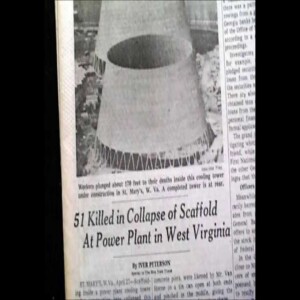

On this day in labor history, the year was 1978.
That was the day a West Virginia cooling tower under construction collapsed, plunging 51 workers to their deaths.
It was considered the worst non-mining disaster in West Virginia and the worst accident in the history of the country’s construction industry.
Cooling towers were under construction at the Pleasants Power Station at Willow Island.
Union building tradesmen built up the walls of the tower from scaffolding bolted to it.
As each section was poured, the forms would be removed and the scaffolding raised and bolted to the new section.
The tower had reached about 168 feet when the previous day’s concrete walls began to peel away from the tower.
The scaffolding plummeted, as did the workers.
Many could only be identified by the contents of their wallets.
The Steele family was beyond devastated with the loss of 10 family members.
A 2008 retrospective by Ken Ward Jr., of the Charleston Gazette reported “…a mix of safety lapses combined to bring the tower crashing down.
Concrete in the previous day’s lift hadn’t hardened enough to hold the scaffolding.
Key bolts meant to attach the scaffolding to the tower were missing.
An elaborate concrete hoisting system was modified without proper engineering review.
Contactors were rushing to speed construction.”
Dr. Celeste Monforton of the Milken Institute School of Public Health noted that the case highlights still relevant issues: Inadequate OSHA penalties, no criminal sanctions, holding workers responsible for contractors mistakes, ignoring of previous warning signs and a disconnect between abstract calculations and real-world applications.
Ken Ward Jr. noted in his retrospective that in 2008, there was still no state public employee OSHA program in West Virginia.
More Episodes
All Episodes>>You may also like
Creat Yourt Podcast In Minutes
- Full-featured podcast site
- Unlimited storage and bandwidth
- Comprehensive podcast stats
- Distribute to Apple Podcasts, Spotify, and more
- Make money with your podcast











